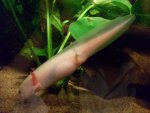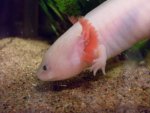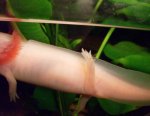Azariel
New member
Hello guys,
That's several days that I noticed Pilku got her arms and legs skin kinda wrinkled. Big wrinkles. The hands are normal.
She also got white spots on the skin of her cheeks, under her mouth, on the knees.
3 days ago I found her waking up with her left leg totally turned up, foot to the sky but still moving. She swims very odd because of that.
Her tail and back legs are also floating up.
She hasn't any tank mate and all water is fine (except the city's water troubles reported previously), she eats normally and poops. Her gills are normal and red.
Please help if you can!
Thank you a lot in advance.
That's several days that I noticed Pilku got her arms and legs skin kinda wrinkled. Big wrinkles. The hands are normal.
She also got white spots on the skin of her cheeks, under her mouth, on the knees.
3 days ago I found her waking up with her left leg totally turned up, foot to the sky but still moving. She swims very odd because of that.
Her tail and back legs are also floating up.
She hasn't any tank mate and all water is fine (except the city's water troubles reported previously), she eats normally and poops. Her gills are normal and red.
Please help if you can!
Thank you a lot in advance.




